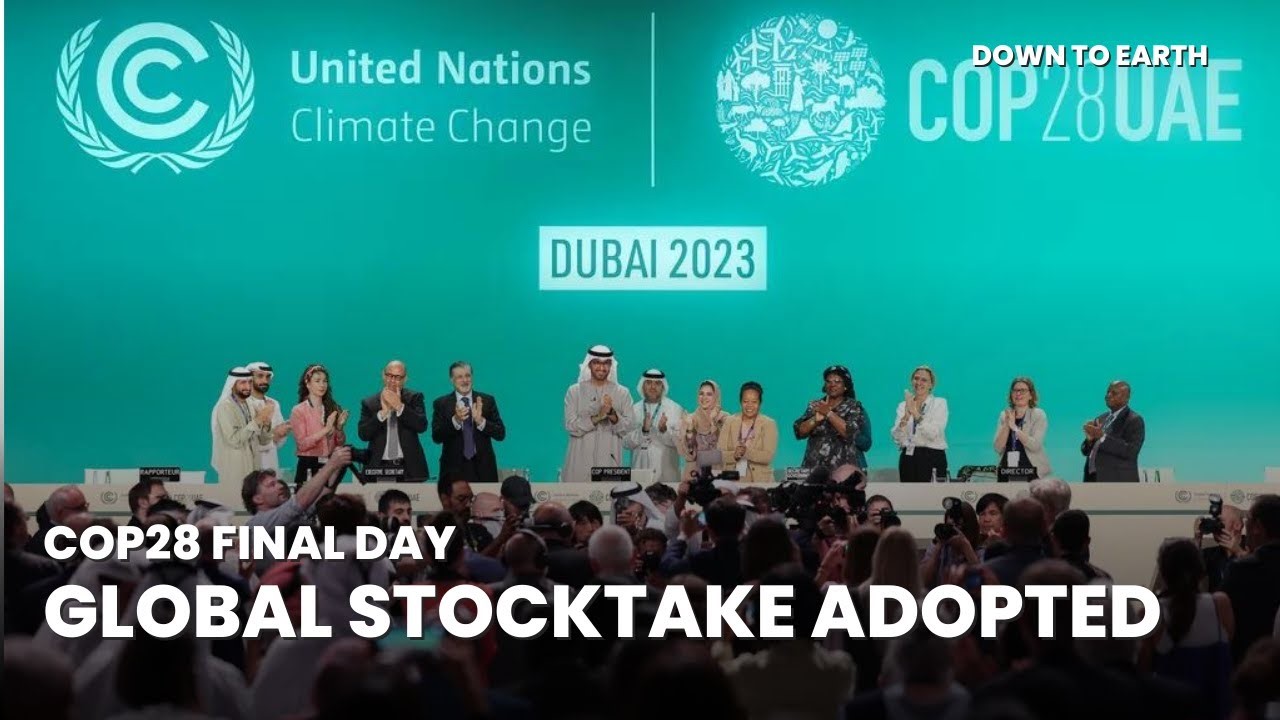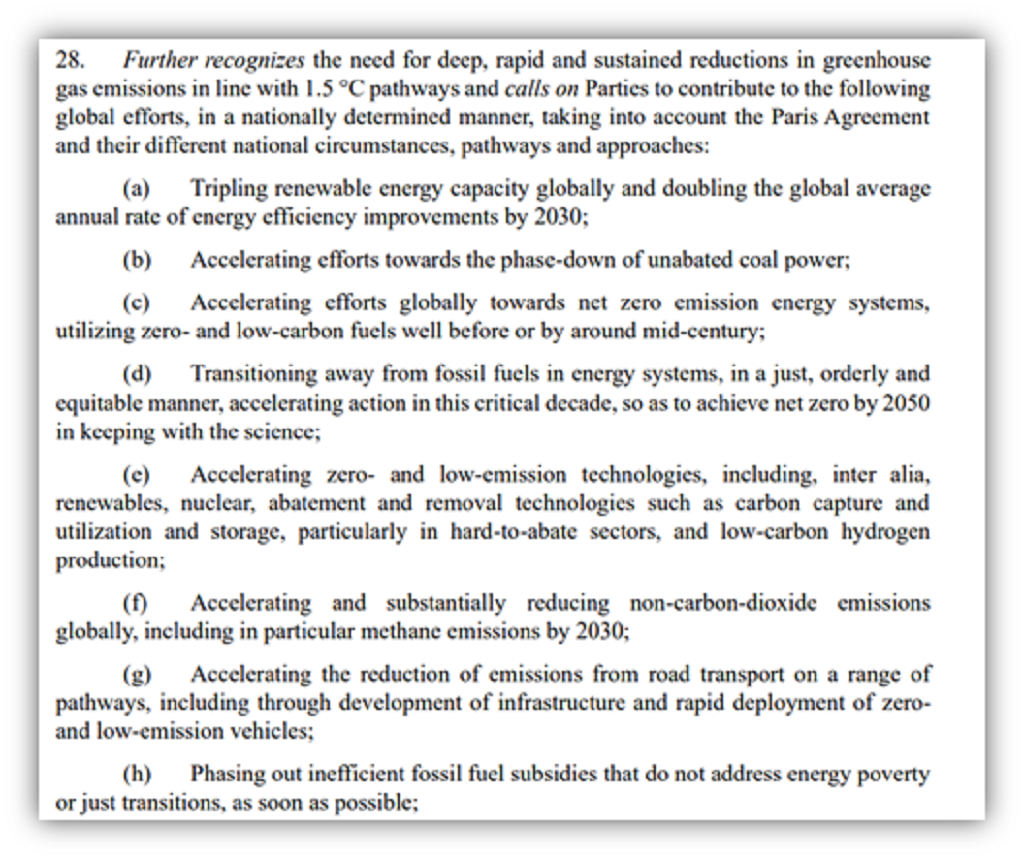Description

Disclaimer: Copyright infringement not intended.
Context
- The fifth (and probably final) iteration of the Global Stocktake (GST) text was released on December 13, 2023 and adopted with no objection at the closing plenary.
- The global stocktake is considered the central outcome of COP28 – as it contains every element that was under negotiation and can now be used by countries to develop stronger climate action plans due by 2025.
READ ALL ABOUT THE CONCEPT OF GLOBAL STOCKTAKE: https://www.iasgyan.in/daily-current-affairs/global-stocktake
Highlights of the Global Stocktake
Fossil fuels
- Following concerns over the last draft which presented a list of actions on fossil fuels countries “could” take, the new iteration seems to have stronger language. It now calls on Parties to follow eight steps taking into account different pathways.
- The phase down of coal no longer includes a stop to new coal generation. An earlier point on “reducing both consumption and production” of fossil fuels has been replaced with “transitioning away”.
- It must not come as a surprise that the language calling out production of fossil fuels is now missing. That is the trade off for taking away the ability for country Parties to approach actions as an optional menu.

- Right after the paragraph on fossil fuels, there is a mention of the role of transitional fuels to achieve the above. This references natural gas and was heavily stressed by Russia and Iran during the negotiations.
- One highlight was the addition of recognising the role of carbon capture storage solutions “particularly in hard to abate sectors”. Emphasised by the European Union, this specification is expected to prevent abatement technology from being used as an excuse to expand fossil fuel production.
- Elsewhere in mitigation, the text has removed the time period of 1850-2019 when talking about the depletion of the carbon budget by historical emissions. It does still, however, explicitly mention the pre-2020 gaps of developed countries in achieving the recommended emissions reduction. This was specifically pushed for by developing countries including India, African Group of Negotiators (AGN) and Group of 77 and China and actively opposed by the United States, EU, Australia and Canada.
- There is a new mention recognising that emissions are projected to peak during 2020-2025 to limit warming to 1.5C. The paragraph also recognises that this peaking will take place in different timelines for countries depending on their national circumstances, thus accepting the different pathways language that many developing groups asked for.
NDCs
- The first line to notice is that the paragraph speaking to countries to come with their next Nationally Determined Contributions (NDC) first reaffirms the nationally determined nature of them. The text also recalls the mandate of the Paris Agreement to provide new NDCs every five years informed by the GST outcomes.
- Developing countries demanded that GST outcomes preserve the national sovereignty in enhancing NDCs. Whether a reaffirmation of the nationally determined nature of NDC will be enough remains to be seen.

There is acknowledgement that the successful achievement of NDCs in developing countries is subject to receiving adequate finance and other support. However, while earlier versions specifically highlighted that this must come from developed countries, there is no such accountability now.
Adaptation
- The adaptation section acknowledges the efforts of countries in developing climate adaptation plans, communications and actions. This recognition was an ask of many countries, particularly the developing. The text also acknowledges the existing gaps in resources for adequate planning in adaptation.

- A paragraph emphasises that adaptation action is critical in this decade and is subject to accelerated financial support.
- However, a stark change shows up in other mentions of adaptation finance. They have all been moved to the means of implementation section from the earlier adaptation section. This ask was specifically from developed countries like the US and Australia. The developing countries had asked for adaptation finance to be part of the adaptation section.
Finance
- The finance section of means of implementation has language specifically acknowledging the obligation of developed countries in leading climate finance. In this new version, there is also wording that climate finance must represent “a progression beyond previous efforts”, a point repeatedly emphasised by Global South groups like the AGN.
- There is a paragraph detailing the role of the private sector in bridging finance gaps. Another one highlights the need to scale up additional, grant-based, highly concessional finance to support the just transition in developing countries. However, there is no specification on who must provide this grant-based finance.
- There were requests by developed countries for the text to acknowledge their efforts in meeting the $100 billion a year goal and very likely having met it this year. The new text instead puts the figure at $89.6 billion in 2021 and a “likelihood” of meeting the goal in 2022.
- Subsequently, it notes the failure in meeting the $100 billion a year goal and encourages developed countries to strive to meet it through 2025 and beyond.

- On adaptation finance, the text calls for a report from developed countries on the doubling of adaptation finance from 2019-2025 next year, along with a call for a high-level ministerial dialogue to address the adaptation finance gap.
- The loss and damage fund has been acknowledged along with a call for developed countries to continue taking the lead to fund it, although only in the finance section and not in the loss and damage section.
- Article 2.1c has been recognised in its complementarity with Article 9 of the Paris Agreement. The former speaks to aligning international finance flows with low carbon development, while the latter recognises that developed countries must provide finance to developing countries to assist both mitigation and adaptation. This complementarity was demanded by many developing countries who feared just a focus on Article 2.1c could be misinterpreted.
SUMMARY
- The stocktake recognizes the science that indicates global greenhouse gas emissions need to be cut 43% by 2030, compared to 2019 levels, to limit global warming to 1.5°C. But it notes Parties are off track when it comes to meeting their Paris Agreement goals.
- The stocktake calls on Parties to take actions towards achieving, at a global scale, a tripling of renewable energy capacity and doubling energy efficiency improvements by 2030. The list also includes accelerating efforts towards the phase-down of unabated coal power, phasing out inefficient fossil fuel subsidies, and other measures that drive the transition away from fossil fuels in energy systems, in a just, orderly and equitable manner, with developed countries continuing to take the lead.
- In the short-term, Parties are encouraged to come forward with ambitious, economy-wide emission reduction targets, covering all greenhouse gases, sectors and categories and aligned with the 1.5°C limit in their next round of climate action plans (known as nationally determined contributions) by 2025.
Helping countries strengthen resilience to the effects of climate change
- The two-week-long conference got underway with the World Climate Action Summit, which brought together 154 Heads of States and Government. Parties reached a historic agreement on the operationalization of the loss and damage fund and funding arrangements – the first time a substantive decision was adopted on the first day of the conference. Commitments to the fund started coming in moments after the decision was gaveled, totaling more than USD 700 million to date.
- There was more progress on the loss and damage agenda with an agreement also reached that the UN Office for Disaster Risk Reduction and the UN Office for Project Services will host the secretariat of the Santiago Network for Loss and Damage. This platform will catalyze technical assistance to developing countries that are particularly vulnerable to the adverse effects of climate change.
- Parties agreed on targets for the Global Goal on Adaptation (GGA) and its framework, which identify where the world needs to get to in order to be resilient to the impacts of a changing climate and to assess countries’ efforts. The GGA framework reflects a global consensus on adaptation targets and the need for finance, technology and capacity-building support to achieve them.
Increasing climate finance
- Climate finance took center stage at the conference, with Stiell repeatedly calling it the “great enabler of climate action.”
- The Green Climate Fund (GCF) received a boost to its second replenishment with six countries pledging new funding at COP28 with total pledges now standing at a record USD 12.8 billion from 31 countries, with further contributions expected.
- Eight donor governments announced new commitments to the Least Developed Countries Fund and Special Climate Change Fund totaling more than USD 174 million to date, while new pledges, totaling nearly USD 188 million so far, were made to the Adaptation Fund at COP28.
- However as highlighted in the global stocktake, these financial pledges are far short of the trillions eventually needed to support developing countries with clean energy transitions, implementing their national climate plans and adaptation efforts.
- In order to deliver such funding, the global stocktake underscores the importance of reforming the multilateral financial architecture, and accelerating the ongoing establishment of new and innovative sources of finance.
- At COP28, discussions continued on setting a ‘new collective quantified goal on climate finance’ in 2024, taking into account the needs and priorities of developing countries. The new goal, which will start from a baseline of USD 100 billion per year, will be a building block for the design and subsequent implementation of national climate plans that need to be delivered by 2025.
- Looking ahead to the transitions to decarbonized economies and societies that lie ahead, there was agreement that the mitigation work programme, which was launched at COP27 last year, will continue until 2030, with at least two global dialogues held each year.
Event participation and inclusivity
- World leaders at COP28 were joined by civil society, business, Indigenous Peoples, youth, philanthropy, and international organizations in a spirit of shared determinationto close the gaps to 2030. Some 85,000 participants attended COP28 to share ideas, solutions, and build partnerships and coalitions.
- The decisions taken here today also reemphasize the critical importance of empowering all stakeholders to engage in climate action; in particular through the action plan on Action for Climate Empowerment and the Gender Action Plan.
Strengthening collaboration between governments and key stakeholders
- In parallel with the formal negotiations, the Global Climate Action space at COP28 provided a platform for governments, businesses and civil society to collaborate and showcase their real-world climate solutions.
- The High-Level Champions, under the Marrakech Partnership for Global Climate Action, launched their implementation roadmap of 2030 Climate Solutions. These are a set of solutions, with insights from a wide range of non-Party stakeholders on effective measures that need to be scaled up and replicated to halve global emissions, address adaptation gaps and increase resilience by 2030.
- The conference also saw several announcements to boost the resilience of food and public health systems, and to reduce emissions related to agriculture and methane.

Significance
- The negotiations on the ‘enhanced transparency framework’ at COP28 laid the ground for a new era of implementing the Paris Agreement.
|
PRACTICE QUESTION
Q. The negotiations at COP28 laid the ground for a new era of implementing the Paris Agreement. Discuss.
|
















